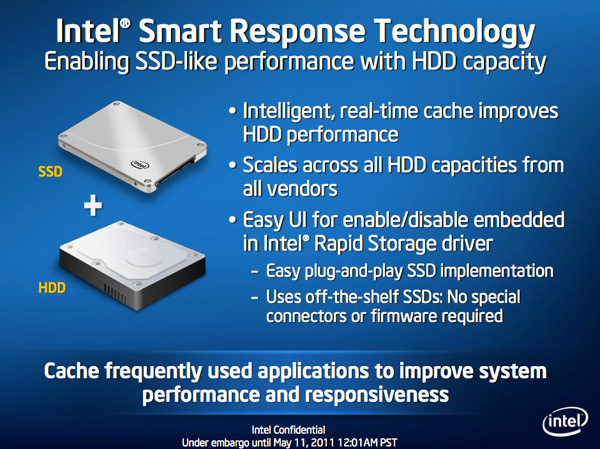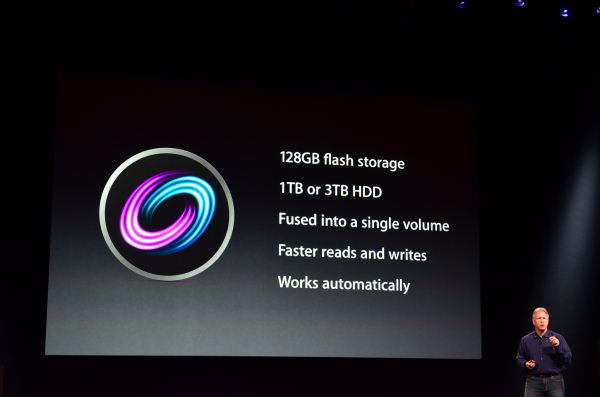A Month with Apple's Fusion Drive
by Anand Lal Shimpi on January 18, 2013 9:30 AM EST- Posted in
- Storage
- Mac
- SSDs
- Apple
- SSD Caching
- Fusion Drive
When decent, somewhat affordable, client focused solid state drives first came on the scene in 2008 the technology was magical. I called the original X25-M the best upgrade you could do for your system (admittedly I threw in the caveat that I’d like to see > 100GB and at a better price than $600). Although NAND and SSD pricing have both matured handsomely over time, there’s still the fact that mechanical storage is an order of magnitude cheaper.
The solution I’ve always advocated was a manual combination of SSD and HDD technologies. Buy a big enough SSD to house your OS, applications and maybe even a game or two, and put everything else on a RAID-1 array of hard drives. This approach works quite well in a desktop, but you have to be ok with manually managing where your files go.
I was always curious about how OEMs would handle this problem, since educating the masses on having to only put large, infrequently used files on one drive with everything else on another didn’t seem like a good idea. With its 6-series chipsets Intel introduced its Smart Response Technology, along with a special 20GB SLC SSD designed to act as a cache for a single hard drive or a bunch in an array.

Since then we’ve seen other SSD caching solutions come forward that didn’t have Intel’s chipset requirements. However most of these solutions were paired with really cheap, really small and really bad mSATA SSDs. More recently, OEMs have been partnering with SSD caching vendors to barely meet the minimum requirements for Ultrabook certification. In general, the experience is pretty bad.
Hard drive makers are working on the same problem, but are trying to fix it by adding a (very) small amount of NAND onto their mechanical drives. Once again this usually results in a faster hard drive experience, rather than an approximation of the SSD experience.
Typically this is the way to deal with hiding latency the lower you get in the memory hierarchy. Toss a small amount of faster memory between two levels and call it a day. Unlike adding a level 3 cache to a CPU however, NAND storage devices already exist in sizes large enough to house all of your data. It’s the equivalent of having to stick with an 8MB L3 cache when for a few hundred dollars more you could have 16GB. Once you’ve tasted the latter, the former seems like a pointless compromise.
Apple was among the first OEMs to realize the futility of the tradeoff. All of its mainstream mobile devices are NAND-only (iPhone, iPad and MacBook Air). More recently, Apple started migrating even its professional notebooks over to an SSD-only setup (MacBook Pro with Retina Display). Apple does have the luxury of not competing at lower price points for its Macs, which definitely makes dropping hard drives an easier thing to accomplish. Even so, out of the 6 distinct Macs that Apple ships today (MBA, rMBP, MBP, Mac mini, iMac and Mac Pro), only two of them ship without any hard drive option by default. The rest come with good old fashioned mechanical storage.
Moving something like the iMac to a solid state configuration is a bit tougher to pull off. While notebook users (especially anyone using an ultraportable) are already used to not having multiple terabytes of storage at their disposal, someone replacing a desktop isn’t necessarily well suited for the same.

Apple’s solution to the problem is, at a high level, no different than all of the PC OEMs who have tried hybrid SSD/HDD solutions in the past. The difference is in the size of the SSD component of the solution, and the software layer.










127 Comments
View All Comments
Galatian - Friday, January 18, 2013 - link
Thanks for pointing this out! I was very interested in getting a new iMac, as I love working on my 13" rMBP, but since I still like to game I really wanted to use the SSD on bootcamp as well. It is a huge step backward for all those people who want/need bigger SSDs. The only other option Apple offers is the 768 GB version for a whopping 1300€ upgrade price. There is no other size in between. Apple has lost me on that one.BrooksT - Friday, January 18, 2013 - link
So Apple is charging $150 to take away the headache of managing files. What you call "gouging" is what many people call "charging for a service."Death666Angel - Friday, January 18, 2013 - link
Again I have to wonder what you do with your PC. It appears as though you have no idea what is on your PC, because even saving a .doc in a specific folder is "managing files". Do you just save everything to desktop? Or download everything from the cloud and then start it from the browser download window?name99 - Friday, January 18, 2013 - link
And I wonder if you have EVER actually(a) viewed how NORMAL people use computers,
(b) used a Mac more recently than ten years ago.
Apple realized a long time ago that people has MASSIVE difficulty dealing with the file system and naming/finding files. Practically every large advance in Apple tech has been to deal with this.
iTunes and iPhoto are about dealing with "songs" and "photos", not "song files" and "photo files". Both create an environment where you never have to give a damn about where your songs and photos are stored or named in the file system. iPod follows the same path, and iOS is the logical endpoint, with no user visible file system.
And this is not new --- did you EVER expect that you should have to manually organized your email files into folders?
In OSX Apple first tried to simplify things with automatically provided folders for the most common situations (Documents, Downloads, Music, Movies, Pictures).
Now, in Mountain Lion Apple is, through a combination of different features (version storage, automatically opening apps at reboot, auto-storing files in iCloud) trying to make it so that, more and more you don't have to name documents created in apps like TextEdit. You CAN, but you don't HAVE TO.
Insisting on manually controlling the placement of your files really does start to come across as no different from insisting on writing assembly code.
Look, I'm not an idiot. I have multiple external hard drives connected to my multiple machines, and I have a purpose for the different hard drives.
The difference between you and me is that I'm not so deluded as to imagine that my needs are in any way typical, and that everyone else would be better off being forced to do things like me.
Death666Angel - Friday, January 18, 2013 - link
I see how other people use PCs. They are managing their stuff, even if they just put documents in a document folder, photos in a photo folder etc. I don't even know what not managing files would look like. Hence why I asked.I don't use Apple products.
I manually organize my Emails to folders in Thunderbird.
I also don't use the Windows libraries or the media player library or any of that stuff. I have no found a program that gave me the ability to organize "non-files" (songs, photos etc.) in a way I found easy to use, well arranged etc. I also like my files to be program/OS independent.
I don't think I'm the typical user. I never said as much.
Your last point though tells me that you don't understand the meaning of my post here. Read the other post that I did not replying to anyone. That should make it clear that I am against this technology. But if someone says he is not managing files, that just sounds dumb (real world equivalent: I don't clean up my closet and have no idea where what is).
KoolAidMan1 - Friday, January 18, 2013 - link
So many spergs in tech forums, it is unbelievable.I'm certain that most of you have low level autism and have no idea how people in the real world are.
Death666Angel - Friday, January 18, 2013 - link
I' pretty sure I'm not. What I am sure of, though, is that you are a dick. :Pkyuu - Saturday, January 19, 2013 - link
People who do the simplest management of their files (saving photos to a Photos folder, music to a Music folder, etc.) have "low-level autism"?The argument that basic file management is hard or a "headache" is absurd. It takes no time at all, and managing files and apps between an SSD and an HDD is no more difficult or time consuming than that.
KoolAidMan1 - Saturday, January 19, 2013 - link
Nope. See this is what I'm talking about.It isn't about lack of technical knowledge, it is about lack of EMPATHY.
Just because you or I or anyone around here can manually manage things doesn't mean that we should bash on automated solutions for normals. I used to write custom config.sys and batch files to get my DOS games to run properly 20 years ago, but I did it because I wanted to play the game, not because I enjoyed jumping through technical hoops.
I'm sure if you told some nerd back in 1993 that maintenance of their games from both the download service and the operating system would be the norm in 20 years, they'd bash on it for not being "hardcore" enough.
Jumping through technical hoops is nothing, you're right, its easy. It also isn't something to hold over the heads of people who don't want to go through that work.
Again, empathy, something so many insecure tech geeks are lacking when it comes to thinking about technology and products.
Galatian - Sunday, January 20, 2013 - link
Apple isn't gauging 150$. They are charging you 250€ for a 128 GB SSD! 250€ = 333$ at the current rate. Not to mention the fact, they simply don't have anything in between. It's either 128GB SSD or 766GB.I'm not sure why everybody is so apologetic about Apple on this one. They gave you much better option on last years models. They actually took options away. While I could deal with a lot of the "anti-consumer" moves that Apple has made late, this is just over the top. The new iMac is nothing more but a bigger Notebook and hence has completely lost it's value as a desktop machine.
Oh and please: How hard is it to manage files? 256 GB is fine for all my files (programs + games). Games I don't play I simply deinstall from Steam. I have a VDSL 50.000 line here, so redownloading them is a no brainer. Same goes for other programs. It must be an American problem with slow inter connections...
Also the way iPhoto handles files is extremely awkward: It actually creates a second copy of the file in another folder. That might me elegant on the surface, but I see absolutely no advantage over simply having a nice hierarchal folder structure. In fact that's what iTunes superbly does. It is a big bag of hurt, that Apple is inconsistent with the way they manage files!